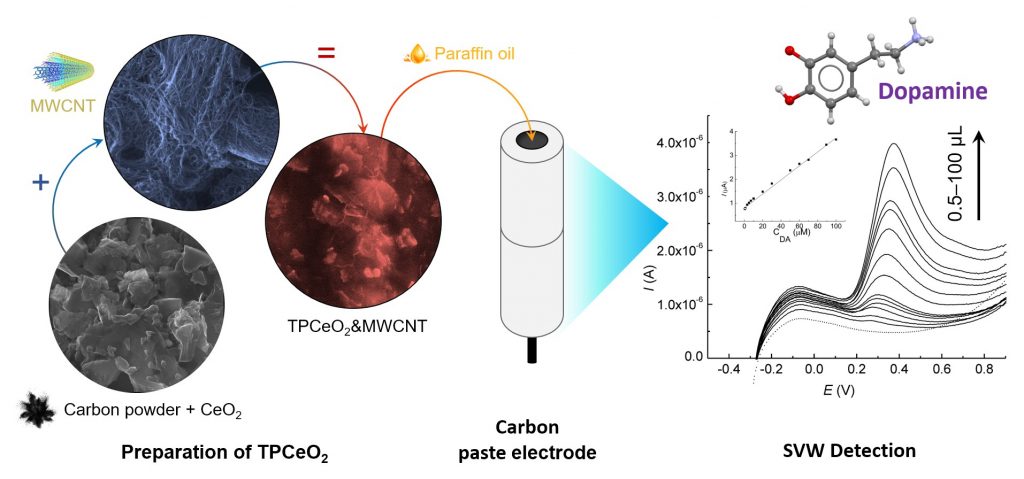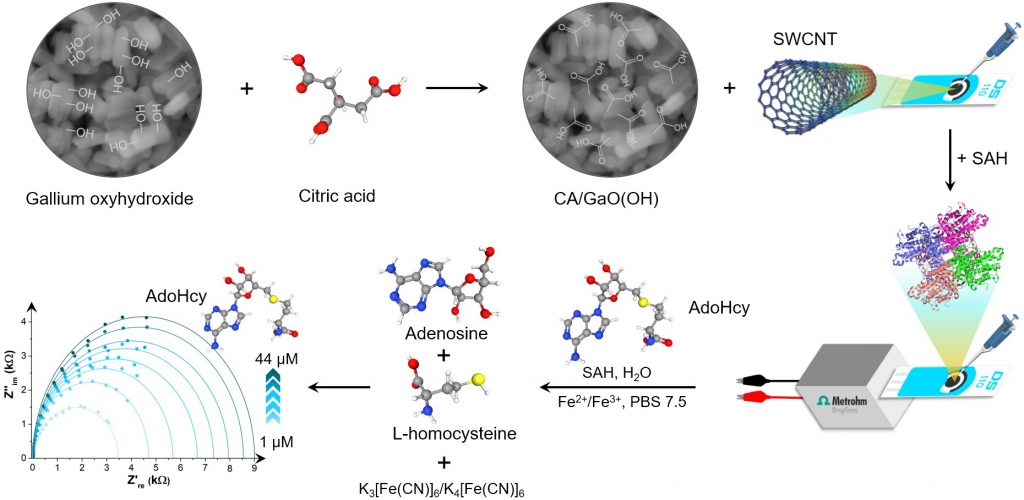A significant part of the research activities is devoted to the application of nanomaterials in the design of electrochemical sensors. Characterization of the prepared nanomaterial-based electrodes is performed by two methods:
- Cyclic voltammetry (CV) – This method is used to obtain information on the response of the electrodes in a standard redox system (usually ferro/ferro redox pair). The response of the electrodes in a given system is monitored in the order of bare (unmodified) electrode – electrode modified with graphene (or its modification) – electrode modified with nanocomposite. The parameters that will decide in the choice of electrode material will be the influence of the modification on the current (an increase of the diffusion current) and the potential (influence on the reversibility/irreversibility) of the tested pair.
- Electrical impedance spectroscopy (EIS) – This method is used to monitor the change in surface resistance and the effect on the diffusion properties of the prepared electrodes. The experiments will be performed in the same order as with CV and based on the change in the capacitive resistance of the system (reduction of the semicircle at lower frequencies) and the slope of the curve after the semicircle (at higher frequencies; diffusion contribution) the best material and modification type will be selected.
The so-obtained results will be used for the development and optimization of electroanalytical methods for the detection of biologically active compounds and environmental pollutants, primarily [1]. As the basic electrodes, a glassy carbon electrode, carbon paste electrodes as well as two types of printed electrodes is used: printed working electrodes and a paper three-electrode system. The first part of the research is based on the use of a direct modification of the electrode surface which will be used as such as electrochemical sensors. The entire development of the method is done by examining the nature of the electrochemical reaction of the target analyte, determining the optimal supporting electrolyte and optimizing the electrochemical detection method (differential pulse voltammetry, square wave voltammetry, amperometry). As a final result, the application of the developed electrochemical method in the analysis of real samples is expected. Samples containing the target analyte were prepared, determined with the developed method as well as some of the standard methods (spectrophotometric, chromatographic, etc.), and the obtained values were compared as a final confirmation of the validity and potential of the obtained method [2].

The second part of the research is focused on the development of electrochemical biosensors for the detection of biological compounds. It is based on the development of biosensors for the detection of glucose content in biological fluids [3]. As basic electrodes in this part, a printed working electrode is used for the development of detection methods in a three-electrode system and a paper three-electrode system for making small electrochemical devices. Newly synthesized materials and composites are used in this part for two purposes: as mediators for electron transfer in enzyme biosensors; as a detection part for the development of, now widely investigated areas, non-enzymatic biosensors [4]. As in the previous section, each method will be optimized in detail and the main objectives will be the operating range, detection limit and selectivity.

Selected references:
[1] Vesna Stanković, Slađana Đurđić, Miloš Ognjanović, Jelena Mutić, Kurt Kalcher, Dalibor M. Stanković: A novel nonenzymatic hydrogen peroxide amperometric sensor based on AgNp@GNRnanocomposites modified screen-printed carbon electrode. J. Electroanal. Chem., 876 (2020) 114487.
[2] Dalibor M. Stanković, Milica S. Jović, Miloš Ognjanović, Andreas Lesch, Martin Fabián, Hubert H. Girault, Bratislav Antić: Point-of-care amperometric determination of L-dopa using an inkjet-printed carbon nanotube electrode modified with dandelion-like MnO2 microspheres. Microchim. Acta 186 (2019) 532-539.
[3] Sladjana Djurdjic, Vesna Vukojevic, Filip Vlahović, Miloš Ognjanović, Lubomir Svorc, Kurt Kalcher, Jelena Mutic, Dalibor M. Stanković: Application of bismuth (III) oxide decorated graphene nanoribbons for enzymatic glucose biosensing. J. Electroanal. Chem., 850 (2019) 113400. [4] Miloš Ognjanović, Dalibor M. Stanković, Yue Ming, Hongguo Zhang, Boštjan Jančar, Biljana Dojčinović, Željko Prijović, Bratislav Antić:Bifunctional (Zn,Fe)3O4 nanoparticles: Tuning their efficiency for potential application in reagentless glucose biosensors and magnetic hyperthermia. J. Alloys Compd., 777 (2019) 454-462.